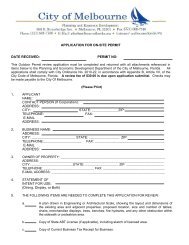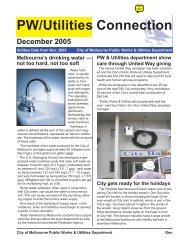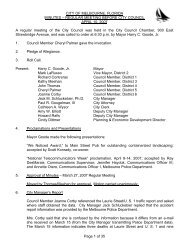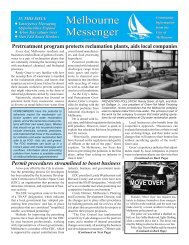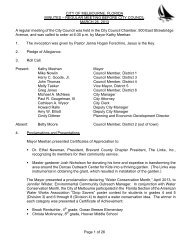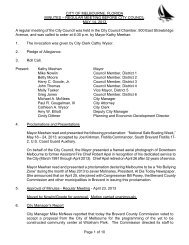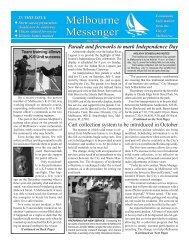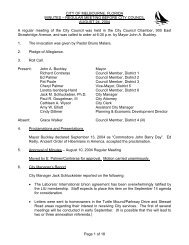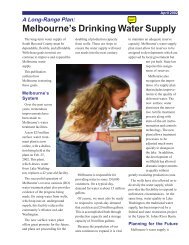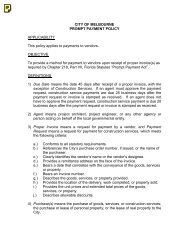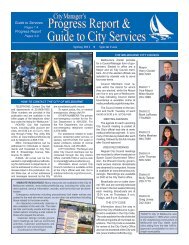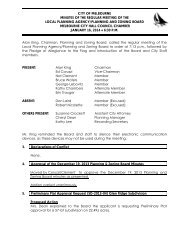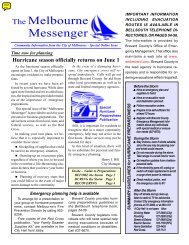Historic Guidelines - City of Melbourne, Florida
Historic Guidelines - City of Melbourne, Florida
Historic Guidelines - City of Melbourne, Florida
Create successful ePaper yourself
Turn your PDF publications into a flip-book with our unique Google optimized e-Paper software.
Landscape and Site Elements<br />
2) Window or wall air-conditioning units should not be installed on the street facades. Central A/C<br />
compressors should be located as far as possible from the street and screened from public view.<br />
3) Universal access ramps, where required, are to be constructed according to code. However, they<br />
should be designed to be as unobtrusive as possible. It is recommended that these should not be<br />
visible from the street. If this is not possible, they should be designed <strong>of</strong> materials similar to those<br />
used on the original building exterior and in harmony with the historic fabric <strong>of</strong> the building.<br />
EXTERIOR LIGHTS<br />
1) Original decorative<br />
fixtures should be<br />
maintained and restored<br />
whenever possible.<br />
2) Floodlights, high intensity<br />
lights or lights that<br />
intrude upon adjacent<br />
properties should not be<br />
used. Lighting the<br />
exterior <strong>of</strong> buildings<br />
within the district must be accomplished without distracting from the harmony and unity <strong>of</strong> the<br />
street. Light sources should be concealed.<br />
3) Light fixtures that are indicative <strong>of</strong> the period and style <strong>of</strong> architecture for each building are<br />
encouraged. Contemporary light fixtures maybe used; however, they should be in an appropriate<br />
scale for the building and should not detract from historic detail.<br />
LANDSCAPING<br />
1) Most commonly, plants are utilized for their aesthetic qualities, but they also serve useful purposes<br />
such as shading and climate control, privacy, erosion control and wind resistance. Landscaping<br />
and site details within the historic district must conform to the requirements <strong>of</strong> the <strong>City</strong> ordinances<br />
governing trees, tree removal, site clearing, and landscaping. These ordinances also provide lists <strong>of</strong><br />
appropriate trees and landscaping for various uses.<br />
2) Landscape elements are important to the overall character <strong>of</strong> the historic district and should be<br />
considered as a part <strong>of</strong> any site rehabilitation or new construction.<br />
3) Live Oak trees are the<br />
Bougainvillea glabra; Bougainvillea Callicarpa americana; Beautyberry<br />
predominant type <strong>of</strong> tree<br />
in the district, and should be<br />
favored as the most<br />
appropriate type <strong>of</strong> street tree<br />
for the district.<br />
4) Stylistic periods in American<br />
garden design did not change abruptly. A list <strong>of</strong> Authentic Plants for Period Landscape Settings in<br />
the Eau Gallie Area (1800’s-1900’s) is included in the Appendix. This partial list is <strong>of</strong>fered as a<br />
beginning point to historic landscape restoration or recreation; it is not inclusive. This list was<br />
compiled by researching lists <strong>of</strong> plants that were most frequently cultivated in 18 - 19th century<br />
American gardens. Only those plants that are appropriate for the 9b hardiness zone (defined by<br />
the United States Department <strong>of</strong> Agriculture hardiness zone map) have been included in the list.<br />
Any historically popular plants that have become invasive exotic plants over time have been omitted<br />
for this list to deter their spread.<br />
DRAFT<br />
REHABILITATION AND ADDITIONS<br />
30



